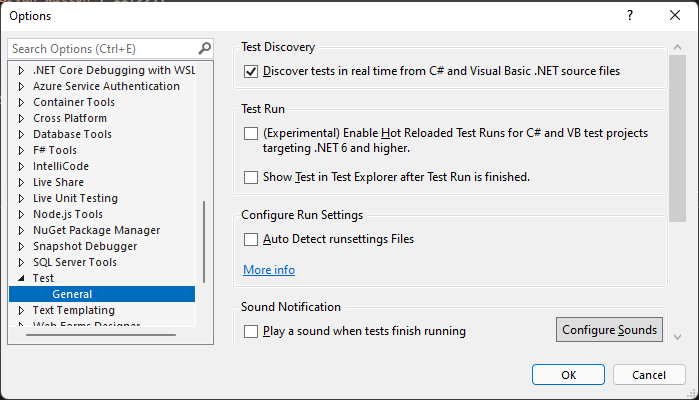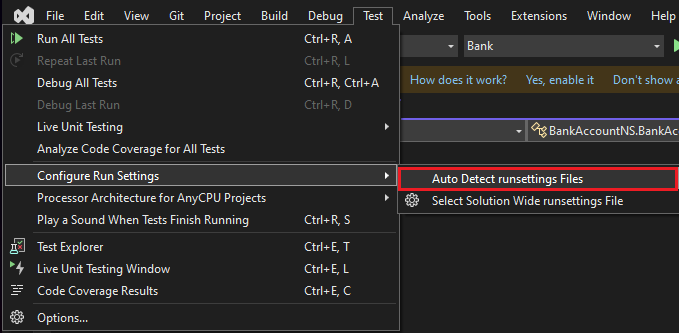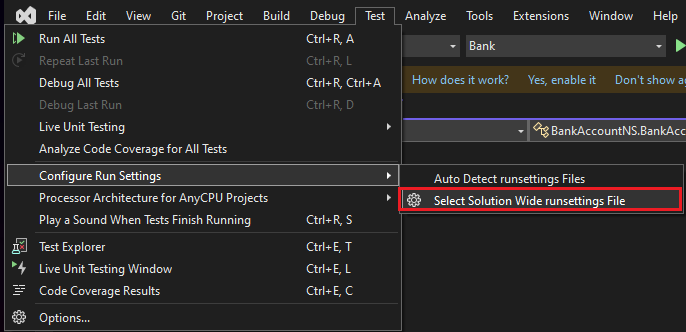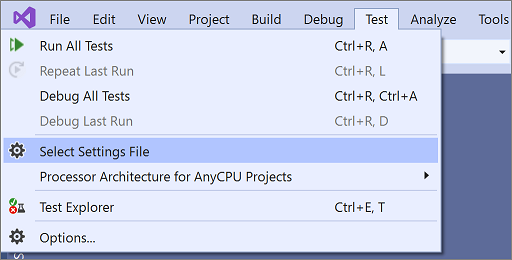使用 .runsettings 文件配置单元测试
.runsettings 文件可用于配置单元测试的运行方式。 例如,它可用于更改运行测试的 .NET 版本、测试结果的目录或测试运行期间收集的数据。 .runsettings 文件常见的用途是自定义代码覆盖率分析。
可以使用运行设置文件配置测试,这些测试可以从命令行、IDE 运行,或者在使用 Azure Test Plans 或 Azure DevOps Server(以前称为 Team Foundation Server (TFS))的生成工作流中运行。
Runsettings 文件是可选的。 如果不需要任何特殊配置,则不需要 .runsettings 文件。
创建运行设置文件并对其进行自定义
将运行设置文件添加到解决方案。 在 解决方案资源管理器中,在解决方案的快捷菜单上,选择“添加>新项,然后选择 XML 文件。 使用 test.runsettings等名称保存文件。
如果未看到所有项模板,请选择 显示所有模板,然后选择项模板。
提示
文件名并不重要,只要使用扩展名 .runsettings。
从 示例 *.runsettings 文件添加内容,然后根据以下各节中所述根据需要对其进行自定义。
请使用以下任一方法来指定您想要的 *.runsettings 文件:
运行单元测试以使用自定义运行设置。
若要禁用和启用 IDE 中的自定义设置,请在“测试”菜单中取消选择或选择文件。
提示
可以在解决方案中创建多个 .runsettings 文件,并根据需要选择一个作为活动测试设置文件。
在 IDE 中指定运行设置文件
可用的方法取决于 Visual Studio 的版本。
Visual Studio 2019 版本 16.4 及更高版本
在 Visual Studio 2019 版本 16.4 及更高版本中指定运行设置文件有三种方法。
自动检测运行设置文件
注意
这仅适用于名为 .runsettings的文件。
若要自动检测运行设置文件,请将其置于解决方案的根目录中。
如果启用了自动检测运行设置文件,则会在所有测试运行中应用此文件中的设置。 可以使用两种方法启用 Runsettings 文件的自动检测:
选择“工具”“选项”>“测试”“自动检测 runsettings 文件”>>

选择“测试”>“配置运行设置”>“自动检测 runsettings 文件”

手动选择运行设置文件
在 IDE 中,选择 测试>配置运行设置>选择解决方案范围的运行设置文件,然后选择 .runsettings 文件。
- 此文件替代解决方案根目录下的 .runsettings 文件(如果存在),并应用于所有测试运行。
- 此文件选择仅保留在本地。

设置生成属性
通过项目文件或 Directory.Build.props 文件向项目添加生成属性。 项目的运行设置文件由属性 RunSettingsFilePath指定。
- C#、VB、C++ 和 F# 项目中当前支持项目级运行设置。
- 为项目指定的文件将替代解决方案中指定的任何其他运行设置文件。
- 这些 MSBuild 属性 可用于指定 runsettings 文件的路径。
为项目指定 .runsettings 文件的示例:
<Project Sdk="Microsoft.NET.Sdk">
<PropertyGroup>
<RunSettingsFilePath>$(MSBuildProjectDirectory)\example.runsettings</RunSettingsFilePath>
</PropertyGroup>
...
</Project>
Visual Studio 2019 版本 16.3 及更低版本
若要在 IDE 中指定运行设置文件,请选择 测试>选择设置文件。 浏览并选择 .runsettings 文件。
 中选择测试设置文件菜单
中选择测试设置文件菜单
该文件显示在“测试”菜单上,你可以选择或取消选中它。 选择后,每当选择“分析代码覆盖率”时,都会应用 runsettings 文件。
从命令行指定运行设置文件
若要从命令行运行测试,请使用 vstest.console.exe,并使用 /Settings 参数指定设置文件。
打开 Visual Studio 的开发人员命令提示符。
输入类似于以下内容的命令:
vstest.console.exe MyTestAssembly.dll /EnableCodeCoverage /Settings:CodeCoverage.runsettings或
vstest.console.exe --settings:test.runsettings test.dll
有关详细信息,请参阅 VSTest.Console.exe 命令行选项。
*.runsettings 文件
*.runsettings 文件是一个 XML 文件,其中包含 RunSettings 元素中的不同配置元素。 以下各节详细介绍了不同的元素。 有关完整示例,请参阅 示例 *.runsettings 文件。
<?xml version="1.0" encoding="utf-8"?>
<RunSettings>
<!-- configuration elements -->
</RunSettings>
每个配置元素都是可选的,因为它具有默认值。
RunConfiguration 元素
<RunConfiguration>
<MaxCpuCount>1</MaxCpuCount>
<ResultsDirectory>.\TestResults</ResultsDirectory>
<TargetPlatform>x86</TargetPlatform>
<TargetFrameworkVersion>net6.0</TargetFrameworkVersion>
<TestAdaptersPaths>%SystemDrive%\Temp\foo;%SystemDrive%\Temp\bar</TestAdaptersPaths>
<TestCaseFilter>(TestCategory != Integration) & (TestCategory != UnfinishedFeature)</TestCaseFilter>
<TestSessionTimeout>10000</TestSessionTimeout>
<TreatNoTestsAsError>true</TreatNoTestsAsError>
</RunConfiguration>
RunConfiguration 元素可以包含以下元素:
| 节点 | 违约 | 价值观 |
|---|---|---|
| MaxCpuCount | 1 | 选项名称区分大小写,并且很容易被误写为 MaxCPUCount。 此设置控制进程级别的并行度。 使用 0 启用最大进程级并行度。 此设置确定可并行运行的测试 DLL 或其他测试容器的最大数目。 每个 DLL 在其自己的 testhost 进程中运行,并在进程级别与其他测试 DLL 中的测试隔离。 此设置不会强制每个测试 DLL 中的测试并行运行。 控制 DLL 中的并行执行(在线程级别)取决于 MSTest、XUnit 或 NUnit 等测试框架。 默认值为 1,这意味着只有一个 testhost 同时运行。 特殊值 0 允许的测试主机数量与逻辑处理器数量相同(例如,对于没有多线程的 6 个物理核心的计算机,则为 6;而对于拥有多线程的 6 个物理核心的计算机,则为 12)。运行中不同 DLL 的数量决定了实际启动的测试主机数量。 |
| ResultsDirectory | 在其中放置测试结果的目录。 该路径相对于包含 .runsettings 文件的目录。 | |
| TargetFrameworkVersion | net40 或 netcoreapp1.0 | 省略此整个标记以自动检测。 此设置定义用于运行测试的框架版本或框架系列。 接受的值是任何框架名字对象,如 net48、net472、net6.0、net5.0、netcoreapp3.1、uap10.0 或任何有效的完整框架名称,如.NETFramework,Version=v4.7.2 或 .NETCoreApp,Version=v6.0.0。 为了向后兼容,Framework35、Framework40、Framework45、FrameworkCore10和 FrameworkUap10 被接受,分别代表net35、net40、net45、netcoreapp1.0 和 uap10.0。 所有值都不区分大小写。提供的值用于确定要使用的测试运行时提供程序。 每个测试运行时提供程序都必须尊重要使用的框架系列,但可能不遵循确切的框架版本: 对于 .NET Framework 4.5.1 - 4.8,将使用通过指定的确切版本生成的 testhost。 对于超出该范围的值,将使用 .NET Framework 4.5.1 testhost。 对于 .NET,测试项目的 <TargetFramework>(或更确切地说 runtimeconfig.json)决定了实际版本。对于 UWP,测试项目应用程序本身充当测试宿主,并确定所使用的 UWP 的具体版本。 省略 TargetFrameworkVersion 文件中的 元素,以自动确定生成的二进制文件中的框架版本。自动检测时,所有目标框架都统一到单个通用框架中。 找到与同一目标框架系列不同的版本时,会选择较新版本(例如 net452、net472、net48 = net48)。 对于 .NET Framework 运行程序(在 Visual Studio 中或开发人员命令行中的 vstest.console.exe),通用目标框架为 net40。 对于 .NET 运行程序(dotnet test + DLL),公共目标框架设置为 netcoreapp1.0。 |
| TargetPlatform | x86 | 省略此整个标记以自动检测。 此设置定义用于运行测试的体系结构。 可能的值为 x86、x64、ARM、ARM64、S390x。自动检测时,AnyCPU DLL 的体系结构可能因运行程序而异。 对于 .NET Framework 运行程序(在 Visual Studio 中或开发人员命令行中的 vstest.console.exe),默认值为 x86。 对于 .NET 运行程序(dotnet 测试),默认值为当前进程体系结构。 |
| 将测试适配器错误视作警告 | false | false、true |
| 测试适配器路径 | TestAdapters 所在目录的一个或多个路径 | |
| TestCaseFilter | 格式为 <属性><运算符><值>的筛选器表达式 [|&<表达式>]。 布尔运算符 & 应由 HTML 实体 &&表示。 表达式可以括在括号中。 有关表达式结构的详细语法,请参阅 vstest/docs/filter.md。 | |
| TestSessionTimeout | 允许用户在超过给定超时(以毫秒为单位)时终止测试会话。 设置超时可确保资源能够得到合理利用,并将测试会话限制在一定时间内。 Visual Studio 2017 版本 15.5 及更高版本中提供此设置。 | |
| DotnetHostPath | 指定用于运行 testhost 的 dotnet 主机的自定义路径。 在您构建自己的 dotnet 时(例如,构建 dotnet/runtime 仓库时),它非常有用。 指定此选项会跳过查找 testhost.exe,并强制使用 testhost.dll。 | |
| TreatNoTestsAsError | false | 真 或 假 指定布尔值,该值定义未发现测试时的退出代码。 如果值 true 且未发现任何测试,则返回非零退出代码。 否则,返回零。 |
DataCollectors 元素(诊断数据适配器)
DataCollectors 元素指定诊断数据适配器的设置。 诊断数据适配器收集有关所测试环境和应用程序的其他信息。 每个适配器都有默认设置,如果不想使用默认设置,则只需提供设置。
<DataCollectionRunSettings>
<DataCollectors>
<!-- data collectors -->
</DataCollectors>
</DataCollectionRunSettings>
CodeCoverage 数据收集器
代码覆盖率数据收集器创建了一份日志,记录测试中哪些部分的应用程序代码被执行。 有关自定义代码覆盖率设置的详细信息,请参阅 自定义代码覆盖率分析。
<DataCollector friendlyName="Code Coverage" uri="datacollector://Microsoft/CodeCoverage/2.0" assemblyQualifiedName="Microsoft.VisualStudio.Coverage.DynamicCoverageDataCollector, Microsoft.VisualStudio.TraceCollector, Version=11.0.0.0, Culture=neutral, PublicKeyToken=b03f5f7f11d50a3a">
<Configuration>
<CodeCoverage>
<ModulePaths>
<Exclude>
<ModulePath>.*CPPUnitTestFramework.*</ModulePath>
</Exclude>
</ModulePaths>
<UseVerifiableInstrumentation>True</UseVerifiableInstrumentation>
<AllowLowIntegrityProcesses>True</AllowLowIntegrityProcesses>
<CollectFromChildProcesses>True</CollectFromChildProcesses>
<CollectAspDotNet>False</CollectAspDotNet>
</CodeCoverage>
</Configuration>
</DataCollector>
VideoRecorder 数据收集器
运行测试时,视频数据收集器捕获屏幕录制。 此录制可用于对 UI 测试进行故障排除。 Visual Studio 2017 版本 15.5 及更高版本中提供了视频数据收集器。 有关配置此数据收集器的示例,请参阅 示例 *.runsettings 文件。
若要自定义任何其他类型的诊断数据适配器,请使用 测试设置文件。
责怪数据收集器
此选项可以帮助你隔离导致测试主机崩溃的问题测试。 运行收集器会在 TestResults中创建一个输出文件(Sequence.xml),该文件捕获崩溃前测试的执行顺序。
可以在三种不同的模式下运行意见:
- 序列文件模式:创建一个包含到挂起为止的测试列表的文件
- 故障转储模式:在 testhost 故障时创建转储
- 挂起转储模式:在给定超时之前测试未完成时创建转储
XML 配置应直接放置在 <RunSettings> 节点中:
<RunSettings>
<RunConfiguration>
</RunConfiguration>
<LoggerRunSettings>
<Loggers>
<Logger friendlyName="blame" enabled="True" />
</Loggers>
</LoggerRunSettings>
<DataCollectionRunSettings>
<DataCollectors>
<!-- Enables blame -->
<DataCollector friendlyName="blame" enabled="True">
<Configuration>
<!-- Enables crash dump, with dump type "Full" or "Mini".
Requires ProcDump in PATH for .NET Framework. -->
<CollectDump DumpType="Full" />
<!-- Enables hang dump or testhost and its child processes
when a test hangs for more than 10 minutes.
Dump type "Full", "Mini" or "None" (just kill the processes). -->
<CollectDumpOnTestSessionHang TestTimeout="10min" HangDumpType="Full" />
</Configuration>
</DataCollector>
</DataCollectors>
</DataCollectionRunSettings>
</RunSettings>
TestRunParameters
<TestRunParameters>
<Parameter name="webAppUrl" value="http://localhost" />
<Parameter name="docsUrl" value="https://learn.microsoft.com" />
</TestRunParameters>
测试运行参数提供了一种方法来定义运行时可用于测试的变量和值。 使用 MSTest TestContext.Properties 属性(或 NUnit TestContext)访问参数:
public TestContext TestContext { get; set; }
[TestMethod] // [Test] for NUnit
public void HomePageTest()
{
string appUrl = TestContext.Properties["webAppUrl"];
}
若要使用测试运行参数,请将公共 TestContext 属性添加到测试类。
LoggerRunSettings 元素
LoggerRunSettings 节定义用于测试运行的一个或多个记录器。 最常见的记录器是控制台、Visual Studio 测试结果文件(trx)和 html。
<LoggerRunSettings>
<Loggers>
<Logger friendlyName="console" enabled="True">
<Configuration>
<Verbosity>quiet</Verbosity>
</Configuration>
</Logger>
<Logger friendlyName="trx" enabled="True">
<Configuration>
<LogFileName>foo.trx</LogFileName>
</Configuration>
</Logger>
<Logger friendlyName="html" enabled="True">
<Configuration>
<LogFileName>foo.html</LogFileName>
</Configuration>
</Logger>
</Loggers>
</LoggerRunSettings>
MSTest 元素
这些设置特定于运行具有 TestMethodAttribute 属性的测试方法的测试适配器。
<MSTest>
<MapInconclusiveToFailed>True</MapInconclusiveToFailed>
<CaptureTraceOutput>false</CaptureTraceOutput>
<DeleteDeploymentDirectoryAfterTestRunIsComplete>False</DeleteDeploymentDirectoryAfterTestRunIsComplete>
<DeploymentEnabled>False</DeploymentEnabled>
<ConsiderFixturesAsSpecialTests>False</ConsiderFixturesAsSpecialTests>
<AssemblyResolution>
<Directory path="D:\myfolder\bin\" includeSubDirectories="false"/>
</AssemblyResolution>
</MSTest>
| 配置 | 违约 | 价值观 |
|---|---|---|
| ForcedLegacyMode | false | 在较旧版本的 Visual Studio 中,MSTest 适配器经过优化,使其更快、更具可缩放性。 某些行为(例如运行测试的顺序)可能不完全如以前版本的 Visual Studio 一样。 将值设置为 true 以使用较旧的测试适配器。 例如,如果你有为单元测试指定的 app.config 文件,则可以使用此设置。 建议考虑重构测试,以便使用较新的适配器。 |
| 设置文件 | 可以在此处指定要用于 MSTest 适配器的测试设置文件。 还可以从设置菜单 指定测试设置文件。 如果指定此值,则还必须将“ForcedLegacyMode”设置为“true”。 <ForcedLegacyMode>true</ForcedLegacyMode> |
|
| DeploymentEnabled | true | 如果将值设置为 false,则测试方法中指定的部署项不会复制到部署目录。 |
| CaptureTraceOutput | true | 捕获来自 Console.Write*、Trace.Write*、Debug.Write* API 的短信,该 API 将与当前正在运行的测试相关联。 |
| EnableBaseClassTestMethodsFromOtherAssemblies | true | 一个值,指示是否启用从与继承测试类不同的程序集中的基类发现测试方法。 |
| ClassCleanupLifecycle | EndOfClass | 如果要在程序集末尾进行类清理,请将其设置为 EndOfAssembly。 (从 MSTest v4 开始不再支持,因为 EndOfClass 是默认的且唯一的 ClassCleanup 行为) |
| MapNotRunnableToFailed | true | 一个值,指示不可运行的结果是否会映射到失败的测试。 |
| Parallelize | 用于设置并行设置: 线程/工作者:用于并行化的线程/工作者数,默认情况下为 当前计算机上的处理器数。 SCOPE:并行化的范围。 可以将它设置为 MethodLevel。 默认情况下,它是 ClassLevel。 <Parallelize><Workers>32</Workers><Scope>MethodLevel</Scope></Parallelize> |
|
| TestTimeout | 0 | 获取指定的全局测试用例超时。 |
| TreatDiscoveryWarningsAsErrors | false | 若要将测试发现警告报告为错误,请将此值设置为 true。 |
| 将类和程序集清理警告视为错误 | false | 若要将类清理失败视为错误,请将此值设置为 true。 |
| 部署测试源依赖关系 | true | 一个值,指示是否要部署测试源引用。 |
| 在测试运行完成后删除部署目录 | true | 若要在测试运行后保留部署目录,请将此值设置为 false。 |
| MapInconclusiveToFailed | false | 如果测试完成返回无结论的状态,则会映射到“测试资源管理器”中的已跳过状态。 如果希望将不确定的测试显示为失败,请将值设置为 true。 |
| ConsiderFixturesAsSpecialTests | false | 若要在 Visual Studio 和 Visual Studio Code AssemblyInitialize 和 AssemblyCleanup 日志中将 ClassInitialize、ClassCleanup、Test Explorer、.trx 显示为单个条目,请将此值设置为 true |
| AssemblyResolution | false | 可以在查找和运行单元测试时指定额外的程序集的路径。 例如,使用这些路径来处理与测试程序集不在同一目录中的依赖程序集。 若要指定路径,请使用 目录路径 元素。 路径可以包括环境变量。<AssemblyResolution> <Directory path="D:\myfolder\bin\" includeSubDirectories="false"/> </AssemblyResolution>请注意,此功能仅在使用 .NET Framework 目标时应用。 |
示例 .runsettings 文件
以下 XML 显示了典型 .runsettings 文件的内容。 复制此代码并对其进行编辑,以满足你的需求。
文件的每个元素都是可选的,因为它具有默认值。
<?xml version="1.0" encoding="utf-8"?>
<RunSettings>
<!-- Configurations that affect the Test Framework -->
<RunConfiguration>
<!-- Use 0 for maximum process-level parallelization. This does not force parallelization within the test DLL (on the thread-level). You can also change it from the Test menu; choose "Run tests in parallel". Unchecked = 1 (only 1), checked = 0 (max). -->
<MaxCpuCount>1</MaxCpuCount>
<!-- Path relative to directory that contains .runsettings file-->
<ResultsDirectory>.\TestResults</ResultsDirectory>
<!-- Omit the whole tag for auto-detection. -->
<!-- [x86] or x64, ARM, ARM64, s390x -->
<!-- You can also change it from the Test menu; choose "Processor Architecture for AnyCPU Projects" -->
<TargetPlatform>x86</TargetPlatform>
<!-- Any TargetFramework moniker or omit the whole tag for auto-detection. -->
<!-- net48, [net40], net6.0, net5.0, netcoreapp3.1, uap10.0 etc. -->
<TargetFrameworkVersion>net40</TargetFrameworkVersion>
<!-- Path to Test Adapters -->
<TestAdaptersPaths>%SystemDrive%\Temp\foo;%SystemDrive%\Temp\bar</TestAdaptersPaths>
<!-- TestCaseFilter expression -->
<TestCaseFilter>(TestCategory != Integration) & (TestCategory != UnfinishedFeature)</TestCaseFilter>
<!-- TestSessionTimeout was introduced in Visual Studio 2017 version 15.5 -->
<!-- Specify timeout in milliseconds. A valid value should be greater than 0 -->
<TestSessionTimeout>10000</TestSessionTimeout>
<!-- true or false -->
<!-- Value that specifies the exit code when no tests are discovered -->
<TreatNoTestsAsError>true</TreatNoTestsAsError>
</RunConfiguration>
<!-- Configurations for data collectors -->
<DataCollectionRunSettings>
<DataCollectors>
<DataCollector friendlyName="Code Coverage" uri="datacollector://Microsoft/CodeCoverage/2.0" assemblyQualifiedName="Microsoft.VisualStudio.Coverage.DynamicCoverageDataCollector, Microsoft.VisualStudio.TraceCollector, Version=11.0.0.0, Culture=neutral, PublicKeyToken=b03f5f7f11d50a3a">
<Configuration>
<CodeCoverage>
<ModulePaths>
<Exclude>
<ModulePath>.*CPPUnitTestFramework.*</ModulePath>
</Exclude>
</ModulePaths>
<!-- We recommend you do not change the following values: -->
<UseVerifiableInstrumentation>True</UseVerifiableInstrumentation>
<AllowLowIntegrityProcesses>True</AllowLowIntegrityProcesses>
<CollectFromChildProcesses>True</CollectFromChildProcesses>
<CollectAspDotNet>False</CollectAspDotNet>
</CodeCoverage>
</Configuration>
</DataCollector>
<DataCollector uri="datacollector://microsoft/VideoRecorder/1.0" assemblyQualifiedName="Microsoft.VisualStudio.TestTools.DataCollection.VideoRecorder.VideoRecorderDataCollector, Microsoft.VisualStudio.TestTools.DataCollection.VideoRecorder, Version=15.0.0.0, Culture=neutral, PublicKeyToken=b03f5f7f11d50a3a" friendlyName="Screen and Voice Recorder">
<!--Video data collector was introduced in Visual Studio 2017 version 15.5 -->
<Configuration>
<!-- Set "sendRecordedMediaForPassedTestCase" to "false" to add video attachments to failed tests only -->
<MediaRecorder sendRecordedMediaForPassedTestCase="true" xmlns="">
<ScreenCaptureVideo bitRate="512" frameRate="2" quality="20" />
</MediaRecorder>
</Configuration>
</DataCollector>
<!-- Configuration for blame data collector -->
<DataCollector friendlyName="blame" enabled="True">
</DataCollector>
</DataCollectors>
</DataCollectionRunSettings>
<!-- Parameters used by tests at run time -->
<TestRunParameters>
<Parameter name="webAppUrl" value="http://localhost" />
<Parameter name="webAppUserName" value="Admin" />
<Parameter name="webAppPassword" value="Password" />
</TestRunParameters>
<!-- Configuration for loggers -->
<LoggerRunSettings>
<Loggers>
<Logger friendlyName="console" enabled="True">
<Configuration>
<Verbosity>quiet</Verbosity>
</Configuration>
</Logger>
<Logger friendlyName="trx" enabled="True">
<Configuration>
<LogFileName>foo.trx</LogFileName>
</Configuration>
</Logger>
<Logger friendlyName="html" enabled="True">
<Configuration>
<LogFileName>foo.html</LogFileName>
</Configuration>
</Logger>
<Logger friendlyName="blame" enabled="True" />
</Loggers>
</LoggerRunSettings>
<!-- Adapter Specific sections -->
<!-- MSTest adapter -->
<MSTest>
<MapInconclusiveToFailed>True</MapInconclusiveToFailed>
<CaptureTraceOutput>false</CaptureTraceOutput>
<DeleteDeploymentDirectoryAfterTestRunIsComplete>False</DeleteDeploymentDirectoryAfterTestRunIsComplete>
<DeploymentEnabled>False</DeploymentEnabled>
<AssemblyResolution>
<Directory path="D:\myfolder\bin\" includeSubDirectories="false"/>
</AssemblyResolution>
</MSTest>
</RunSettings>
在 .runsettings 文件中指定环境变量
可以在 .runsettings 文件中设置环境变量,该文件可以直接与测试主机交互。 在 .runsettings 文件中指定环境变量是支持需要设置环境变量(如 DOTNET_ROOT)的非临时项目所必需的。 这些变量是在生成测试主机进程时设置的,它们在主机中可用。
例
下面的代码是传递环境变量的示例 .runsettings 文件:
<?xml version="1.0" encoding="utf-8"?>
<!-- File name extension must be .runsettings -->
<RunSettings>
<RunConfiguration>
<EnvironmentVariables>
<!-- List of environment variables we want to set-->
<DOTNET_ROOT>C:\ProgramFiles\dotnet</DOTNET_ROOT>
<SDK_PATH>C:\Codebase\Sdk</SDK_PATH>
</EnvironmentVariables>
</RunConfiguration>
</RunSettings>
RunConfiguration 节点应包含 EnvironmentVariables 节点。 可以将环境变量指定为元素名称及其值。
注意
由于在启动测试主机时应始终设置这些环境变量,因此测试应始终在单独的进程中运行。 为此,当存在环境变量时,将设置 /InIsolation 标志,以便始终调用测试主机。